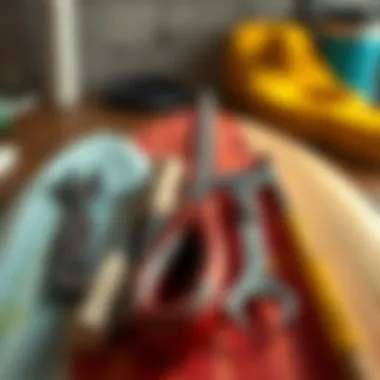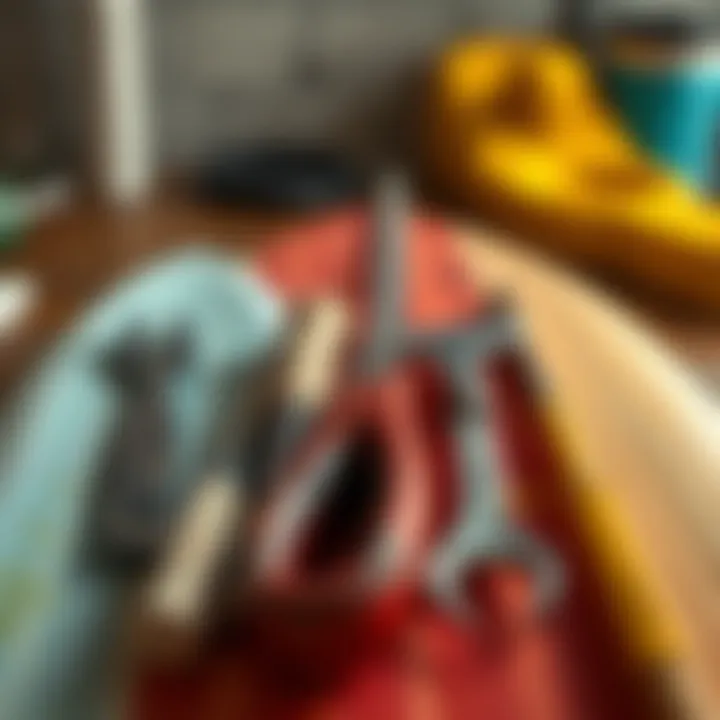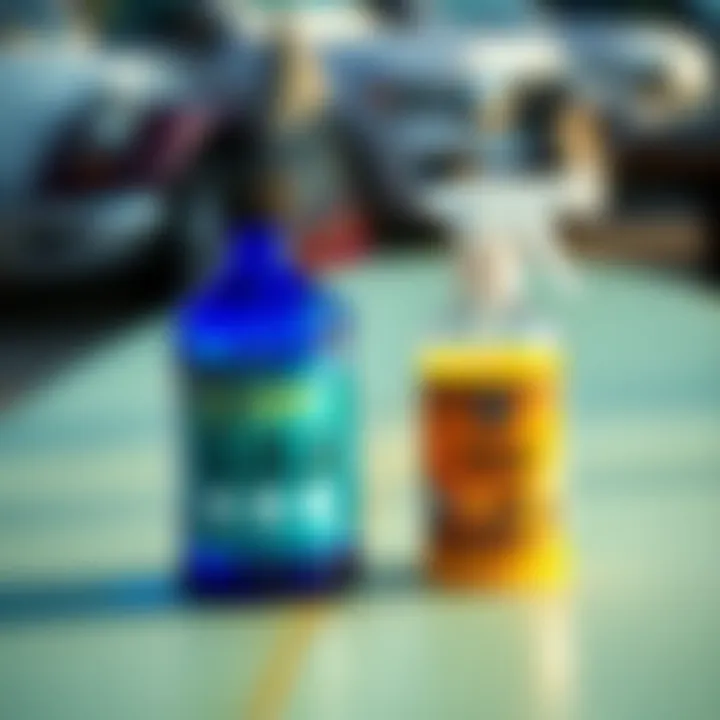Top Strategies for Effective Wax Removal from Surfboards


Intro
Surfing is more than a hobby; it's a lifestyle intertwined with the spirit of the ocean. And like any serious sport, maintaining your equipment is crucial for optimal performance. One key aspect many surfers often overlook is the necessity of keeping their surfboards clean—specifically, removing wax buildup. Wax helps to provide grip, but too much of it can weigh you down, affecting your ride.
Understanding the effective strategies for removing wax from your surfboard is essential, and this guide dives into various methods and tools. The goal here is to not only get your board into top shape but also to consider the environment—because, let’s face it, surfers are part of a community that has a unique responsibility towards nature.
In this article, we will explore how to effectively scrape, scrub, and ultimately rejuvenate your surfboard using techniques that are both practical and eco-friendly. Whether you're new to surfing or a seasoned pro, keeping your board clean ensures you’ll ride smoother waves and extend the lifespan of your gear.
So, let’s slice through the wax and get started on this essential aspect of surfboard maintenance.
Understanding Surfboard Wax
Surfboard wax is more than just a slippery coat; it’s a critical component for any surfer. Knowing its composition and purpose provides context to why and how we maintain a clean board. Just as a well-tuned engine is essential for a smooth ride, so too is clean wax for optimal surfing performance. Understanding surfboard wax helps surfers make informed choices about their gear and self-care routines.
Composition of Surfboard Wax
Surfboard wax is primarily made up of natural and synthetic ingredients that create a sticky surface. Most commonly, paraffin, beeswax, and various additives are blended to enhance performance depending on water temperature and surfer preference. This unique formula gives the wax its tacky texture needed for grip.
For instance, cold water wax contains a higher ratio of harder waxes to ensure grip in chilly conditions, while tropical wax is softer, suitable for warmer waters. It's essential to choose the right type of wax according to the conditions, as it can significantly affect ride quality.
Purpose of Wax on a Surfboard
The primary role of wax is to prevent slipping while riding waves. Think of it as an adhesive layer that helps your feet stick onto the board. It creates necessary friction which allows a surfer to shift weight and maneuver effectively. This adherence not only aids in performance but also keeps the rider safe. A slippery board in the middle of a wave can lead to falls and injuries, so good wax application is paramount.
Other purposes include:
- Enhanced Control: It allows surfers to execute turns and maneuver through waves with confidence.
- Prevention of Water Accumulation: A good layer of wax can help in reducing the water that accumulates on the board's surface.
- Protective Coating: Besides performance, wax acts as a protective barrier against UV rays and scratches, prolonging the board's lifespan.
Given its importance, regularly assessing the condition of the wax is vital. If it’s flaky and dull, it’s time for a removal and re-application. This attention to detail not only maximizes performance but also enhances overall experiences on the water.
"A good surf day begins with a well-prepped board. Never underestimate the power of wax!"
In summary, a solid grasp of surfboard wax's composition and purpose lays the groundwork for understanding why regular cleaning and maintenance are crucial for optimal surf performance.
Significance of Cleaning Your Surfboard
Keeping a surfboard clean isn’t just about aesthetics; it plays a crucial role in performance and longevity. Regularly cleaning the wax off your board ensures that you can rely on its performance when riding the waves. Surfers might overlook it, but the sticky layer of wax that offers grip can turn into a hindrance if it gets too thick or dirty. A clean board can carve through the water better, making each ride smoother and more enjoyable.
Impact on Performance
The difference between a well-maintained surfboard and one caked in old wax can be stark. Imagine palming a basketball that’s sticky and grimy—your grip would be inconsistent, right? Similarly, as wax collects dust, sand, and grime, it loses its effectiveness. A cluttered layer impacts your balance; without proper grip, your surfboard might slip underfoot. Here are some key performance factors:
- Grip Efficiency: Fresh wax provides the necessary traction for paddling and turns. Old wax can become slippery or uneven.
- Hydrodynamic Advantage: Clean surfaces enhance flow; unique contours of a board are designed for streamlined performance, which can be compromised by accumulated wax.
- Handling: A lighter and cleaner board is more responsive to adjustments and maneuvers, directly influencing your surfing style.
"A clean board can make the difference between a perfect ride and a wipeout. Don’t let old wax steal your stoke!"
Aesthetics and Longevity
While the sentimental values of a board are irreplaceable, its appearance matters, too. An unkempt surfboard is akin to a well-loved pair of jeans—faded and worn may feel good, but getting them cleaned makes a substantial difference in appearance and durability. When it comes to maintaining your surfboard:
- Visual Appeal: A shiny, clean board just looks more inviting. It shouts ‘I care about my gear’ and can even make an impression in a lineup.
- Preserving Material Integrity: Surfboards are often made of materials that can degrade with neglect. Old wax can trap moisture against the foam, leading to issues like delamination and mold, which not only impacts performance but also the lifespan of the board.
- Reducing Repairs: By regularly cleaning your board and keeping it in good shape, you’re likely to avoid costly repairs down the track. Accumulated wax can mask minor damages, making them worse over time.
Tools and Materials Needed
When it comes to removing wax from your surfboard, having the right tools and materials is as essential as knowing the waves. Using the proper equipment can save time, protect the board, and ensure a thorough clean. It's not just about scraping off wax; having the right approach reaps benefits in terms of board longevity and performance.
Basic Scraping Tools
To start with, basic scraping tools are paramount. These include a plastic scraper or a specially designed surfboard wax comb. Plastic is preferred as it won't damage the surfboard's surface. A metal scraper might seem tempting due to its sturdiness, but it carries the risk of scratching, which can negatively affect hydrodynamics.


- Wax Comb: A tool every surfer should have in their gear. These combs are designed to remove wax without harming the finish of the board. Available in various shapes and sizes, they can reach tight spots effectively.
- Spatula: In the absence of a comb, a spatula can serve in a pinch. Just make sure it’s plastic to avoid gouging.
- Rubbing Alcohol: This can help loosen stubborn wax and is an easy cleaning agent.
While it might sound trivial, investing in a quality comb makes a world of difference. Plus, keeping it handy means you're always ready for a clean-up, whether it's after a long session or during maintenance.
Solvents and Chemicals
Next in line are solvents and chemicals. This category requires cautious selection since not all chemicals are suitable for surfboards and care must be taken to avoid damaging your equipment. A common household item, such as mineral spirits or lighter fluid, can come in handy for tougher wax build-up.
- Recommended Solvents:
- Acetone: Effective for wax removal but can be harsh, so use sparingly and only on specific boards where it's deemed safe.
- White Spirit: A good alternative that's less aggressive than acetone but still effective for stubborn patches.
Remember, while these chemicals can be effective, it’s also wise to ventilate your space and use gloves. Some surfboard materials may react adversely, so checking compatibility is a must!
Eco-Friendly Alternatives
In today's conscientious world, eco-friendly alternatives are valuable. Surfers are becoming increasingly aware of their impact on the environment, which is reflected in the choices they make. Luckily, there are biodegradable wax removers that provide effective cleaning without the chemical fallout.
- Coconut Oil: Not only does this smell pleasant, it can also help break down wax without harming the environment. A simple application can soften the wax, making it easier to scrape away.
- Cornstarch and Soap Mix: Combine cornstarch and a gentle soap for a natural removal solution. This mixture is less abrasive and still effective.
Opting for these eco-conscious methods means you can surf freely, knowing you’re not contributing to the degradation of your favorite coastal spots. Furthermore, being mindful about the tools and chemicals used can inspire a more sustainable surfing culture, encouraging future surfers to follow suit.
"Every time you wax it up or strip it back, remember: your surfboard is a reflection of your respect for the waves and the environment."
In summary, gathering the right tools and materials is the cornerstone of an effective wax removal strategy. By opting for quality scraping tools, careful selection of solvents, and eco-friendly alternatives, you set yourself up for not just a clean board, but also a lasting impact on your surfing experience and environment.
Preparing Your Surfboard for Wax Removal
Before diving into the nitty-gritty of wax removal, it's crucial to understand that this process doesn't just involve scraping with abandon or dousing your board in chemicals. Preparing your surfboard properly lays the groundwork for an effective and safe wax removal, ensuring you don’t damage the board while optimizing your efforts and results.
Surface Assessment
When you assess the surface of your surfboard, you’re not just looking for where the wax is caked on the most – although that’s a part of it. It’s important to check for dings, cracks, or any other damage that might have gone unnoticed. If you start scraping away at an area with a hidden issue, you could exacerbate the damage and potentially lead to costly repairs down the road.
- Check for Imperfections: Take a close look at the board. An area that would usually feel smooth may actually harbor a small crack that you weren’t aware of.
- Inspect Wax Buildup: Note where the wax buildup is heaviest. This will guide your effort to remove it effectively while being gentle at the same time.
- Clean Residues and Debris: Before the actual removal process, wipe down the surfboard with a soft, dry cloth. This removes dust and dirt that could scratch the surface.
- Identify Material: Know the type of surfboard you’re dealing with, as different materials may react differently to certain removal methods.
By conducting a thorough surface assessment, you pave the way for a more strategic and effective cleaning process.
Safety Precautions
Taking safety into account might seem like common sense, but it’s better to be safe than sorry. Removing wax may seem rudimentary, yet the tools and chemicals involved can pose risks if not handled properly.
- Use Gloves: When dealing with solvents or tools, protect your hands with gloves. Not only does this prevent irritation from chemicals, but it also ensures a better grip on scraping tools.
- Eye Protection: It might be wise to wear safety glasses, especially if you're using high-pressure sprays or scratching off hard wax layers. A small piece of wax flying into your eye could be quite annoying!
- Ventilation is Key: If you’re using solvents, do it in a well-ventilated area. Inhaling fumes isn’t just uncomfortable; it can be harmful.
- Awareness of Surroundings: Ensure your workspace is organized, with tools laid out nicely. This reduces the chances of accidents or mishaps. For instance, using a metal scraper on a fragile section might not end well.
Adopting these safety measures not only helps in protecting yourself but also in keeping your surfboard in top-notch shape during the entire wax removal affair. After all, a clean board is a happy board, but a careful approach keeps it smiling too.
Scraping Off the Wax
Removing wax from a surfboard isn't just a chore; it’s a crucial maintenance step that can have a substantial impact on your surfing experience. Wax buildup can affect grip and slide, making it difficult to paddle out and catch that perfect wave. The first step in keeping your board in top condition is proper waxing—and equally essential is knowing how to effectively remove that wax when it's time.
Scraping off the wax is a fundamental skill that every surfer should have in their toolkit. Not only does it help maintain the board’s surface, but it also prolongs its lifespan. Wax can hold dirt and residue that might scratch the fiberglass if not removed properly. Moreover, when you keep the board clean, you also enhance its performance, which is especially vital when you find yourself beneath the sun and surf. All in all, regular waxing removal keeps your riding experience smooth and enjoyable.
Initial Scraping Techniques
When you decide it's time to remove the wax, starting right will set the tone. First, grab a dedicated surfboard wax comb; it often has a sharp edge for scraping and a blunt edge for finer details. A razor blade can work too, but be mindful not to gouge the board.
Begin by holding the comb at about a 45-degree angle to the board and apply gentle but firm pressure as you draw it along the surface. Remember: quick, short strokes usually yield better results than long scrapes. This minimizes the chance of damaging the board and helps to lift the wax off easily. You’ll notice the wax curling up into little strips—this is a good sign!
After getting a majority off, switch to the blunt edge of the wax comb for the finer details.
Don’t rush this part. Take your time to get into the nooks and crannies where wax tends to hide. An orderly, methodical approach will not only show you results but will also save you a headache later.


Handling Stubborn Buildup
Sometimes, you can encounter a sticky situation. That stubborn wax, the kind that seems to have fused with the board, can really test your patience. If scraping alone isn’t cutting it, you might need to bring in some reinforcements.
One simple way to deal with it is to heat the wax. Use a hairdryer or a heat gun on the low setting to warm the affected area. This won’t melt the board but will soften the wax, making it easier to scrape off. Just keep the heat moving; you don’t want to concentrate it too long in one spot.
After softening, the scraping process becomes significantly easier, allowing you to work through that tough buildup with more success.
- If you find yourself really struggling, consider applying a small amount of wax remover or a light solvent before scraping. Just ensure any chemical used is safe for your board type.
What’s key here is patience and the right technique. If you push through stubborn wax without the proper approach, you risk damaging your board. Hence, accept that sometimes less is more, and give yourself the time you need to effectively handle stubborn situations.
Using Solvents for Wax Removal
When it comes to properly maintaining a surfboard, removing wax is an essential process that plays a crucial role, particularly when it involves using solvents. Solvents can make wax removal not only easier but also more thorough. They effectively break down wax, especially when it has hardened over time or when layers have built up. With the right solvent, you save time and energy, allowing you to spend more time on the waves and less in the cleaning bay.
Choosing the Right Solvent
Picking a solvent isn’t just a roll of the dice; it’s about understanding the properties of each option. Here are some popular solvents:
- Mineral Spirits: This solvent is effective and relatively safe to use. It helps break down the wax without harming the surfboard’s finish if applied correctly.
- Turpentine: Known for its effectiveness, turpentine is a strong solvent that can handle tough wax buildup. However, be mindful of the strong odor.
- Acetone: Acetone works wonders on wax, but it’s potent and may strip other finishes if not used carefully. It needs to be treated with respect.
- Eco-Friendly Options: There are products available that are biodegradable or plant-based, suitable for surfers who are keen to minimize their environmental impact. Always check labels to ensure the solvent doesn’t contain harsh chemicals.
Think about what you need, and don’t hesitate to test a small area before diving into the whole board.
Application and Techniques
How you apply the solvent is just as important as which one you choose. Here are some techniques that streamline the process:
- Preparation: Before applying any solvent, ensure you have a clean workspace. Lay the surfboard down on a soft surface to avoid scratches.
- Application: Using a clean cloth, dampen it with the chosen solvent. You don’t want it dripping; just enough to wet the area is sufficient. Circle the cloth on the waxed surface, allowing the solvent to soak in for a minute. This helps the solvent penetrate and loosen the wax.
- Scraping: After the wait, take a non-abrasive scraper or a plastic putty knife, and gently scrape off the wax. The combination of the solvent and scraping should do the trick.
- Cleaning Up: Post-scraping, use another clean cloth to wipe down the surfboard and remove any residual solvent or remaining wax. Ensure no solvent is left on the board to avoid damaging the finish.
- Ventilation: Always work in a well-ventilated area. The fumes from solvents can be overwhelming and harmful.
By following these guidelines, wax removal will be a less daunting task, letting you maintain your board's performance without much hassle.
Eco-Conscious Wax Removal Options
As we ride the waves, it’s essential to keep in mind the ripple effects of our actions on the environment. The process of removing wax from surfboards often includes using various chemicals and solvents that can harm marine ecosystems if not managed correctly. Therefore, eco-conscious wax removal options are not just trendy; they’re vital for preserving the beautiful waters we surf in. By adopting environmentally-friendly methods, surfers can take a stand against pollution and contribute to a healthier planet while maintaining their boards in peak condition. This section delves into the biodegradable solutions available alongside important considerations for minimizing ecological impact.
Biodegradable Solutions
When it comes to surfboard wax removal, opting for biodegradable solutions is a smart move. These products are formulated to break down naturally over time, reducing the risk of lingering pollutants in our oceans. Here are some effective biodegradable options to consider:
- Plant-Based Solvents: Many brands now offer wax removers made from plant-derived ingredients. These products are often just as effective as traditional solvents but without the harsh chemicals. Look for brands like Green Goo or Simple Green that cater to eco-conscious surf enthusiasts.
- Homemade Solutions: If you prefer a DIY approach, vinegar mixed with warm water can help dissolve wax. Citrus oils, like lemon or orange, are also effective and can leave a refreshing scent.
- Eco-Waxes: Consider using eco-wax that is not just biodegradable but also free from harmful toxins. This prevents unnecessary buildup that can complicate removal while ensuring your board is ready to go when you hit the surf.
Using these biodegradable products not only helps to keep your surfboard clean, but they also encourage a sustainable approach to surfing. By adopting such methods, surfers can contribute to minimizing pollution in their local beaches and oceans, showing that respect for nature is as important as the next big wave.
Environmental Considerations
In contemplating eco-conscious wax removal options, it’s crucial to consider the broader environmental implications. Here are some aspects that every surfer should keep in mind:
- Impact on Marine Life: The chemicals found in traditional wax removers can lead to both immediate and long-term harm to fish, coral reefs, and other marine organisms. Even the smallest amounts can disrupt the delicate balance of the underwater ecosystem.
- Water Contamination: Many common solvents can contaminate waterways, affecting not just marine life but also the quality of water for recreational activities. This contamination can result in washing up toxic residues on beaches, making them unsafe for swimming and other activities.
- Sustainable Practices: Beyond the choice of products, think about the overall habits when it comes to surfboard maintenance. For instance, routine cleaning of wax instead of waiting for heavy buildup can minimize the need for harsh removers. Consider creating a cycle of checking your board and cleaning it regularly to keep it in good shape and decrease reliance on aggressive products.
By making conscious choices about the wax removal process, surfers can play a pivotal role in minimizing environmental footprints. From the products we choose to the methods we employ, every decision counts. Remember, a clean surfboard also leads to cleaner waves and a healthier ocean!
"Conscientious choices today can lead to vibrant oceans tomorrow."
For more on eco-friendly surfing, visit Surfrider Foundation.
Post-Removal Care
After you've meticulously removed wax from your surfboard, there are a few essential steps to follow to ensure your board remains in top-notch condition. Post-removal care isn’t just a box to tick off; it genuinely affects the performance and longevity of your board. Let's delve into two crucial aspects of post-removal care: inspecting the board for damage and reapplying wax for optimal performance.
Inspecting the Board for Damage


Once the wax is off, giving your surfboard a good once-over is not just a good idea, it’s an essential practice. Scratches, dings, or other imperfections may be lurking under the coat of wax that has been hiding them. If you skip this step, you might let minor issues escalate into larger ones that could doom your board.
When inspecting, look for:
- Dents or Dings: Small lumps or indentations can weaken your board. They may cause water to seep in, which is a recipe for disaster.
- Cracks: Hairline fractures might not seem like a big deal, but they can compromise the integrity of the board if left unattended.
- Delamination: If the layers of the board appear separated, that’s a big red flag. This typically needs fixing by a professional.
Being proactive means you can address these issues immediately. If you see something amiss, consider a repair to avoid further damage. Different types of boards require different approaches to repairs, so a quick reference to appropriate methods might be needed. Sites such as reddit.com can offer community advice on how to handle specific board types.
Reapplying Wax for Optimal Performance
Once your board is cleaned and any damages addressed, it's time to think about wax. A clean board is meant to be surfed, and to do this, you need to apply wax properly. By reapplying wax, you're ensuring that the grip is back to what it should be, which is crucial for performance on the water.
Before slapping on a new layer of wax, consider these factors:
- Type of Wax: Choose a wax that aligns with your surf conditions—warm water wax for sunny shores or cold water wax for brisker environments. Using the wrong type can lead to slippage when you need grip the most.
- Application Method: Generally, a circular motion works best. Make sure you cover high-traffic areas like the tail and nose. A thin, even layer is more beneficial than a thick one, as it allows for better traction.
- Condition of the Surface: Ensure the area you are waxing is clean and dry after removal. Any residual solvents or moisture could affect adhesion.
Incorporating a regular waxing routine as part of your surfing habit will not only protect your board but also enhance performance. Many surfers find that frequent applications lead to a more enjoyable ride; hence it becomes crucial to keep things fresh.
"A waxing job done right can feel like driving a Ferrari instead of a family sedan!"
To sum up, the care you give after wax removal can significantly impact your surfing experience. Not only does inspecting for damage help prolong the life of your board, but proper reapplication of wax ensures you're not left floundering when you catch that perfect wave.
Overall, being attentive to the small details in the care of your surfboard reflects on your performance in the water. Keeping a keen eye post-cleaning is a hallmark of a serious surfer, and it pays dividends both in enjoyment and performance.
Tips for Regular Maintenance
Regular maintenance of your surfboard, particularly regarding wax removal and application, is vital for several reasons. It not only enhances your board's performance but also prolongs its lifespan. By keeping your surfboard clean, you can experience better grip while paddling and riding the waves, which makes a huge difference when you're out on the water. A clean board also looks better, and let’s face it, nothing feels as good as riding a board that’s in top shape.
Maintaining your surfboard should be viewed as a routine activity rather than an occasional chore. When you implement a few simple habits, you'll ensure that your board remains in optimal condition longer. Moreover, creating a wax removal schedule and sticking to best practices for wax application will help you avoid problems down the line.
Creating a Wax Removal Schedule
Establishing a wax removal schedule helps to integrate maintenance into your surfing routine. Just like you wouldn't skip a surf session without checking the conditions, keeping track of your board's wax build-up is equally important. When to remove wax? Typically, surfboard wax needs a good scrub every few sessions, but this can vary depending on your wax choice and the conditions you surf in.
- Frequency of Use: If you're out surfing multiple times a week, it might be wise to clean your board every two to three sessions. Conversely, less frequent surfers might find once a month sufficient.
- Conditions: Surfing in warmer waters can lead to faster wax degradation. If you notice you're slipping on your board or not feeling secure, it’s probably time for a wax touch-up.
- Build-up Inspection: After each surf session, take a quick glance at your board. If it starts to look messy or feel slippery, that’s a sign it’s time to remove the old wax.
By marking when you last removed the wax on a simple calendar or using a note on your phone, you'll turn it into a habit. Consistency is key to maintaining optimum performance.
Best Practices for Wax Application
Once you’ve mastered the art of wax removal, the next step is applying wax efficiently. Proper application is crucial because it directly affects how your board feels while riding.
- Clean Surface: Before applying new wax, make sure your board is completely clean. Any residue from the old wax will prevent the new wax from adhering properly.
- Choose the Right Wax: Pick wax designed for the climate conditions where you surf. Warmer waters often require softer wax, whereas colder situations need harder options.
- Apply in a Circular Motion: When applying, use a circular motion, starting from the center of the board and working your way outwards. This creates a textured surface that improves grip.
- Layering: It’s a good idea to apply multiple thin layers rather than one thick slab. Thin layers help ensure there’s just enough texture for grip without becoming goopy.
- Regular Checks: Make it a point to check the wax before you hit the waves. If you notice areas that feel too slick or uneven, simply add a bit more or redistribute as needed.
Incorporating these strategies not only prepares your board for better performance but also fosters an attitude of care that benefits both you and your equipment. Remember, a well-cared-for surfboard is a happy surfboard, translating to better rides and enjoyable sessions on the water.
"A penny saved is a penny earned." Similarly, time spent maintaining your surfboard today will save you much more in performance issues tomorrow.
Closure
When it comes to removing wax from a surfboard, there's more at stake than just a clean board. The conclusion of this article synthesizes the essential methods and considerations involved in this process, highlighting why it matters. A surfboard's performance can greatly decline if it’s not kept well, as a wax layering can inhibit grip and buoyancy. Furthermore, the act of keeping the surfboard clean extends its lifespan, saving both time and money in the long run.
Summarizing Key Points
Recapping from earlier sections, a few vital points emerge:
- Regular cleaning isn't just good practice; it impacts performance and feel on the water.
- Knowing the right tools and methods can simplify the wax removal process, making surf days more enjoyable.
- It’s crucial to prioritize environmentally-friendly options when choosing solvents and tools to maintain not just your board, but the waters we surf in.
In practical terms, whether employing serious scraping techniques or opting for solvents, it's all about the approach and materials used. Equipping yourself with knowledge on the best practices solidifies a surfer's bond with the craft and environment on which they rely.
Encouraging Sustainable Surfing Practices
In the spirit of fostering a culture of sustainability in the surfing community, we must recognize that our actions influence the ecosystems we cherish. Surfers can lead by example through these efforts by:
- Using biodegradable wax and removal solutions that minimize environmental harm.
- Advocating for brands that prioritize sustainable materials and eco-conscious production.
- Participating in local beach clean-ups to preserve surf spots and habitats.
Ultimately, encouraging sustainable practices isn't just about the wax we use—it's a ripple effect that touches the entire surfing community. By making better choices, we can ensure that future generations enjoy the same waves and waters we do today, with minimal impact on the environment.



